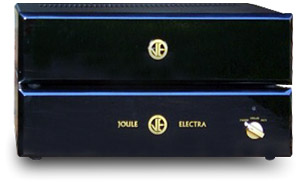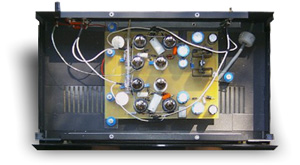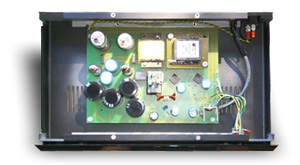![[SoundStage!]](../sslogo3.gif) The Vinyl Word The Vinyl WordBack Issue Article |
||||||||||||||||||||
| September 2001 Joule Electra OPS-2 Mk V Phono Stage by Bill Cowen
As an audio company, Joule Electra is probably best known for their well-regarded OTL tube amplifiers. I’ve seen and heard their wares many times at shows (usually coupled with Merlin speakers), and the sound has always been very appealing, even with the compromises inherent in a show venue. Having never had the opportunity to lay my own hands on a piece of Joule Electra equipment, I jumped at the chance to listen to the OPS-2 Mk V. But would a Joule Electra phono stage meet the high-water mark established by company's the amplifiers? Description The OPS-2 Mk V is currently the top-level phono preamp offering from Joule Electra. It offers the same gain capability as the less expensive OPS-1Mk V, but it sports an additional pair of tubes. Strictly speaking, the OPS-2 Mk V is a two-box affair -- one for the head unit, and a second for the power supply, interconnected by a lengthy umbilical. If, however, the purchaser already owns one of the company’s line preamps (from the LAT series), the preamp's power supply can be modified to power the OPS-2 Mk V as well, thus reducing the price of entry. The modification to the power supply is performed at the factory for no charge (excluding shipping costs) when the OPS-2 Mk V is purchased. The OPS-2 Mk V costs $3700 USD with its own power supply, $2700 powered from the preamp. Both the head unit and power supply are enclosed in matching black chassis with gloss-black acrylic faceplates. While the aesthetic won’t likely win any art-deco awards, both boxes are attractive and nicely finished, and they exude a subtle, minimalistic approach to exterior design. Both units measure 17"W x 9"D x 4"H; the head unit weighs ten pounds and the power supply 15. On the back of the power-supply unit, a male IEC receptacle for mains power and the female receptacle for the head unit’s umbilical are all that exist. On the front is a single rotary knob that selects between off, mute, operate and standby. An LED resides directly above the rotary selector and changes color depending on the function selected. On the head unit, the front is devoid of anything but the Joule Electra logo badge. On the back are the (captive) umbilical, a pair of RCA output jacks, a two-position push-button for gain selection, and two pairs of input jacks. One set of inputs is for the phono leads from the tonearm. The other set facilitates loading by way of inserting a male RCA plug into the input. Soldering a resistor and/or capacitor into this plug allows for custom configuration of the desired loading value(s). I find this method to be pretty dang cool. It’s quite easily configured, yet requires no soldering or de-soldering inside the unit. Plugs with the desired values (made from high-quality parts) can be purchased from Joule Electra to alter the factory-set resistance load of 47k ohms. But for the terminally cheap (like me), it’s pretty simple to make up your own. Note that parts quality is of considerable importance at the low signal level encountered here, so if you do make your own, don’t cheap out on substandard jacks, resistors, or capacitors. Tube complement for the power supply is a pair of 0A2s and a pair of 6EM7s. The head unit gets four 5751s, a pair of 6DJ8s, and a pair of 6350s. Each tube has a proprietary metal shield arrangement surrounding the glass bulb(s), and this shield is interconnected and shunted to ground to reduce noise and RFI pickup. Of particular note is that the OPS-2 Mk V achieves its gain solely through the use of thermionic devices. There are no transistors or step-up transformers utilized to achieve the high gain required for most moving-coil cartridges. Every phono stage I’ve had through these parts in the last year has used one or the other, so the OPS-2 Mk V is a departure from the norm for these ears.
Finally, there are two gain settings for the OPS-2 Mk V: 36dB for higher output cartridges, and 62dB for lower-output (moving-coil) cartridges. It's important to note that the OPS-2 Mk V does not invert phase in the low-gain (36dB) position, but it does invert phase in the high-gain (62dB) position. If using the high-gain position in a system that is otherwise phase correct, be sure to swap cartridge leads to maintain proper phase. Setup and use As with most high-performance audio components, the OPS-2 Mk V benefits from proper support. I achieved great results with it resting on its factory feet atop Greater Ranges Neuance shelve(s) supported by a SolidSteel rack. Further, an improvement resulted by separating the head unit from the power supply (contrary to the accompanying photo). With the head unit sitting directly on top, a low-level hum emerged from the speakers. Separating the units by one shelf eliminated this hum entirely. I experienced a significant improvement in sound with the unit left in standby mode when I wasn't listening. From a cold power-up, the OPS-2 Mk V didn’t come alive until it had warmed up for at least a couple of hours. When left in standby mode, however, it sounded quite good after only about 20 minutes into full operate mode. Designer Jud Barber recommends leaving the unit in standby (rather than a complete shutdown) when not listening unless you don’t plan on listening for quite some time, which a proper audiophile would never consider anyway. With that out of the way, I began to put the OPS-2 Mk V through its paces. Cartridges on hand were both moving coils: the Dynavector Te Kaitora (.25mV output), and the Benz Micro MC-SCHEU (.33mV output). With everything else being equal, the Te Kaitora is a much more dynamic and effortless-sounding cartridge than the Benz, yet coupled with the OPS-2 Mk V, it actually sounded somewhat less dynamic. Although the background-noise level was still very quiet, I suspected that the lower output of the Te Kaitora was delving into uncomfortable gain territory for the OPS-2 Mk V. I shot off an e-mail to Jud Barber and asked for his opinion on the matter. He commented that the lowest-output cartridge he had personally used with the OPS-2 Mk V was a .4mV Cardas Heart, and that a .25mV output cartridge may well not be enough for the OPS-2 Mk V to handle comfortably. My experience concurs -- consider a minimum of .33mV output if you want to hear the OPS-2 Mk V (and your LPs) at their best. While the difference between these output levels may seem trivial, consider that the .33mV output is nearly 25% higher than the .25mV output. And at this signal level, that’s significant. Perhaps Barber will address the super-low-output cartridges with an OPS-3. Tunes The first thing that struck me about the OPS-2 Mk V was its silence. Between LP cuts, only a faint hiss was audible from the listening position, and this with the preamp’s volume control set to a normal listening level. How Joule Electra fashioned this much quiet gain from an all-tube unit is beyond me, but impressive nonetheless. Beyond that, what immediately caught my attention was how incredibly musical the OPS-2 Mk V was. Personally, I just hate it when I see the word "musical" thrown about with no qualification as to its meaning. And I suspect that it means different things to different people. To me, musical sound occurs when the brain steps aside and the soul takes over. It’s when your leg begins to hurt from an unconscious, uncontrolled foot-tap. It’s when you quit listening for sonic traits and start listening for artistic talent and interpretation. For me, this occurs when the midrange is alive with tonal color, and harmonics are allowed to develop and decay completely and naturally. It occurs when nuance, micro detail, and microdynamic shifts are free to establish themselves as part of the musical whole. It occurs when the treble is free from hype or etch, and absent aggressive and/or irritating traits. It occurs when dynamics (on the macro level) startle, stimulate, and explode. And it occurred for me while listening to the OPS-2 Mk V. "You and Your Friend," from Dire Straits' On The Night [Vertigo, 514 766-1], is a nicely rendered live recording that is, well, alive with audience noise and involvement. The chants and clapping came across in a rhythmic whole, with a superb portrayal of timing that made the entire presentation involving. I’ve heard the high guitar notes on this recording come across a bit stridently with other phono stages, but the OPS-2 Mk V, while still bringing out the fundamental tone, did so in a bit more forgiving manner. Low bass-guitar notes had good weight and body, but were slightly less robust in the very lowest registers. Switching to Tchaikovsky’s Cappricio Italien, with Kiril Kondrashin conducting the RCA Symphony Orchestra [RCA LSC-2323] gave a good glimpse of the OPS-2 Mk V’s tonal presentation. While I have this same piece on the flip side of Telarc’s famous 1812 Overture LP, I find the RCA recording to be less a hi-fi spectacular and more inclusive of the subtle details of a full symphony orchestra. Brass instruments came across with first-rate resonance and blat. While the OPS-2 Mk V was more to the forgiving side of the spectrum than the analytical, there was no sense of veiling or syrupy tube coloration. Stringed instruments were rendered nearly perfectly, and, in fact, were more believable and lifelike than from any phono stage I’ve yet to hear -- strident (but not edgy) at times, and silky smooth and sweet at others. Soundstage information was very nicely rendered. Width extended well to the outside of the speaker cabinets, and the depth was seemingly extended beyond the front wall. Cymbals and triangles were lifelike, yet I felt just slightly curtailed at the very highest frequency extremes. This was not to the point of sounding rolled off or closed in, but better described as just missing that last ounce of air and "tinkle."
On the dynamic side of things, the OPS-2 Mk V could provide startling macrodynamics, yet never to the point of sounding artificial or hyped. "Papa Legba" from Talking Heads True Stories LP [Sire 255 12-1] can be explosive in its overall dynamic presentation, but it also provides some good insight into matters microdynamic. The OPS-2 Mk V scaled the soft-to-loud passages with ease and dexterity, and portrayed transient attacks instantaneously. Drum whacks had appropriate weight and punch, with superb definition. The vocals on this cut can be a little raspy around the edges, and while the OPS-2 Mk V didn’t mask this trait, it made it a little less bothersome. Sweetening? Not really -- it was more of a slight change in character that came across as a little more polite, and less reproduced-sounding. Finally, John Lee Hooker’s The Healer [Chameleon, D1-74808] was a real joy via the OPS-2 Mk V. Image outlines were solid, properly sized, and well placed within the soundstage. Hooker’s somewhat rough-hewn voice came right on into the mix, separate and distinct, yet cohesive and integrated with the instruments. Carlos Santana’s expert fretwork was marked by its intonation and expression. This particular recording loses most of its artistic value if a component (or system) has difficulty with rhythm and timing relationships. It can also lose its magic if the presentation is too thin, or lacks body and instrumental dimension. The OPS-2 Mk V just shines in these areas, and brought the performance right into the listening room. Comparison The Cary PH301 Mk 2 is my reference phono stage, and at $3500 is priced just slightly below the OPS-2 Mk V standalone combo. It uses a pair of transformers for moving-coil step-up duty, and as with the OPS-2 Mk V, it is a tube-based unit. Tonally, the two units could be kissing cousins. Both are on the warm side of neutral, and both serve up a heaping platter of dimension, body, and palpability in the midrange. Of all the phono stages I’ve had on hand over the past year -- each with its own distinct sonic flavor -- I was surprised that units from different manufacturers could sound as much alike as the OPS-2 Mk V and PH301 Mk 2. Moving away from the tonal arena highlights some differences, however. The Cary plumbs deeper in the bass, offering a bigger chunk of slam and wham-bam. Subterranean synthesizer notes, for example, literally shake the walls. With the OPS-2 Mk V, the tone, inflection and weight are there, but the crunch factor is decidedly lighter in character. In the treble, the Cary once again seems to take the extension to just a little higher level. There’s more air and sparkle, yet the degree of this is rather minor comparatively. The OPS-2 Mk V picks up the accolades when it comes to midrange texturing and micro-detail retrieval. This explains to a large degree the appeal of the OPS-2 Mk V to me, as those qualities are high on my personal list. The OPS-2 Mk V also shines with its vanishingly low surface and background noise. Conversely, the Cary seems to accentuate surface noise and record defects, projecting them further forward (and sometimes distractingly so) into the musical mix. Differences aside, both units are exceedingly enjoyable to listen to, and both get at the heart of the musical message. Conclusion In short, the Joule Electra OPS-2 Mk V brought about an undeniable emotional attachment to the music. While my brain could find a few things to fuss over, my soul got lost in the tunes it played. It is vitally important to mate the OPS-2 Mk V with a cartridge of sufficient output, as much of what it brings to the sonic table is diminished if that requirement isn’t given the proper consideration. And for someone who places ultimate frequency extension at the top of his personal requirement list, the OPS-2 Mk V may not be the best choice. Conversely, for someone who simply wants to enjoy music without obsessing over the extraneous details, the OPS-2 Mk V may be a gift from heaven. ...Bill Cowen
|
||||||||||||||||||||
|
||||||||||||||||||||
![[SoundStage!]](../sslogo3.gif) All Contents All ContentsCopyright © 2001 SoundStage! All Rights Reserved |


